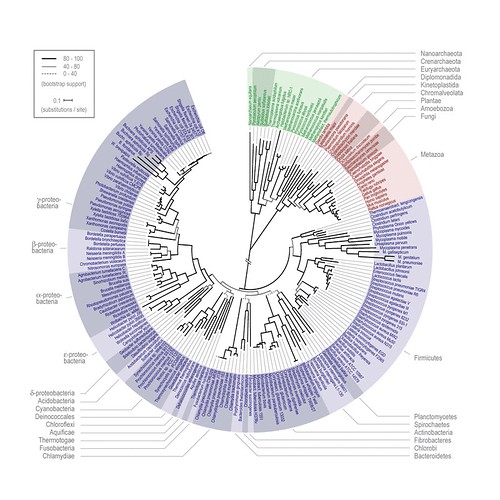
Zimmer's article does a great job of explaining what the tree is, and how to read it, so if you're not used to reading phylogenies just pop over there to learn more. It really is a thing of beauty; my SO and I each spent probably more than
The phylogeny was created by comparing the sequences of 31 genes shared by organisms that have had their entire genomes sequenced. This limitation to include only completely sequenced organisms partially explains the lack of eukaryotes (animals, plants, etc.), as they're much more difficult to sequence. One thing that is somewhat irksome to this entomologist, however, is that only two species of insects (~.00026% of all named insect species; both are flies) were included, while seven chordates were included (~0.014% of all named chordate species), but that's just a symptom of the bias of genome sequencers (and researchers in general).
For those who are curious, here are the common names (and descriptions, where appropriate) of the eukaryotes included:
- Protists
- Giardia lamblia - A eukaryote that lacks mitochondria; causes giardiasis.
- Leishmania major - A trypanosome that is "an intracellular pathogen of the immune system targeting macrophages and dendritic cells"; causes Leishmaniasis. Other trypanosomes include the causal agents of Chagas disease and sleeping sickness.
- Thalassiosira pseudonana - A marine diatom.
- Plasmodium falciparum - One of four species in the Plasmodium genus that cause malaria.
- Cryptosporidium hominis - An apicomplexan (the same phylum of protists as Plasmodium) that causes diarrhea.
- Dictyostelium discoideum - An amoeboid slime mould (or, as the Nature genome article calls them, "social amoebae").
- Plants (and algae)
- Cyanidioschyzon merolae - A unicellular red alga "that inhabits sulphate-rich hot springs (pH 1.5, 45 deg C)".
- Arabidopsis thaliana - Thale cress; a small, fast-growing annual used frequently in plant genetics research.
- Oryza sativa - Rice.
- Fungi
- Schizosaccharomyces pombe - Fission yeast, commonly used in genetics.
- Saccharomyces cerevisiae - Bakers' and brewers' yeast.
- Eremothecium gossypii - A multicellular ascomycete (sac fungus) that is a pathogen of cotton and other crops; commonly known ascomycetes are morels and truffles. Apparently also known as Ashbya gossypii.
- Animals
- Caenorhabditis briggsae - A nematode worm similar to C. elegans.
- Caenorhabditis elegans - A nematode worm commonly used in genetics and developmental biology.
- Drosophila melanogaster - A fruit fly commonly used in genetics and developmental biology. Some prefer the common name vinegar fly.
- Anopheles gambiae - A mosquito, one of 30-50 species of Anopheles that transmit malaria.
- Danio rerio - Zebrafish.
- Takifugu rubripes - Pufferfish.
- Gallus gallus - Domesticated chicken (red junglefowl).
- Pan troglodytes - Common chimpanzee.
- Homo sapiens - Humans.
- Mus musculus - House mouse, including lab mice and pet mice.
- Rattus norvegicus - Norway rat, and the common lab and domesticated rat.
(via my dad, who waxed rhapsodic about the figure on the phone tonight)
Update 3/5 12:30pm - Curious about all those non-eukaryotes? The Genome News Network has an illustrated quick guide to sequenced genomes that comes complete with the common name of the organism, a summary of its ecology, and why it was sequenced. They also have a very useful alphabetical index.
Ciccarelli, FD, T Doerks, C von Mering, CJ Creevey, B Snel, and P Bork. 2006. Toward Automatic Reconstruction of a Highly Resolved Tree of Life. Science 311:5765. pp. 1283 - 1287 (abstract)



1 comment:
Importing comments:
Trackback
Trackback message
Title: A Very Pretty Picture
Excerpt: A very pretty picture (click on the image to make it larger): Go read what Carl Zimmer and Rhosgobel have to say. For more on the Tree of Life, go here....
Blog name: evolgen
March 6, 2006, 12:40:11 AM PST – Like
RPM
It's nothing personal. One of my pet peeves is the misnomer that Drosophila are fruit flies. Every time I see it pop up I make it a point to articulate the difference.
March 5, 2006, 4:03:40 PM PST – Like – Reply
Radagast
I just updated the post to clarify the Drosophila entry.
March 5, 2006, 2:43:08 PM PST – Like – Reply
Radagast
Fixed the tag.
March 5, 2006, 2:05:42 PM PST – Like – Reply
Radagast
From a technical perspective, you are correct, as family Tephritidae are known as fruit flies. However, there is no good alternate common name for Drosophila; the term "vinegar fly" is probably the most commonly used alternate (e.g., Bland 1978 ), but hardly anyone outside of entomology knows Drosophila by that name, and thus people generally just use the Latin name.
I would argue that the term fruit fly is widely accepted to refer to Drosophila (see, for instance, the wikipedia, and many other google hits), and since the entire point of the post was to allow a lay reader to translate the Latin names to common names they would recognize, defining Drosophila melanogaster as a "Drosophila" or "vinegar fly" would have been inadequate.
And, as a final note, I did part of my graduate work on several Drosophila species. We always referred to them either as "Drosophila" or, especially when talking to the public, "fruit flies".
March 5, 2006, 2:04:55 PM PST – Like – Reply
RPM
Oops, forgot to close a tag...
March 5, 2006, 12:54:47 PM PST – Like – Reply
RPM
One thing that is somewhat irksome to this entomologist, however, is that only two species of insects (~.00026% of all named insect species; both are flies) were included...
Drosophila melanogaster - A fruit fly.
If you're gonna express your dismay at biased phylogenetic sampling and the lack of insect species, at least get the common name of Drosophila correct. I'd expect an entomologist to know that "fruit flies" are Tephritids.
Edited By Siteowner
March 5, 2006, 12:53:59 PM PST
Post a Comment